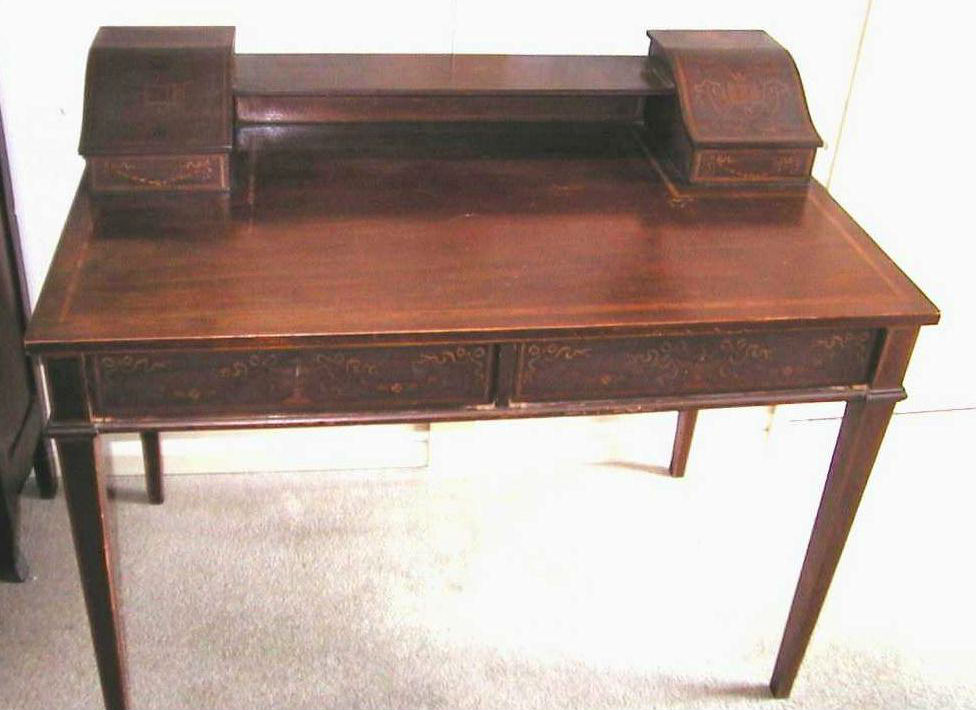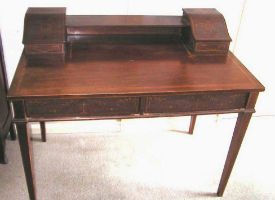
CRYSTAL RIVER, Fla. – I have previously written the requirement of knowing something about a craftsman or a company before taking it for granted that a recognizable name was a guarantee of quality goods. Brand name quality in furniture, as in almost everything else, has a tendency to rise and fall over time for a variety of reasons and it is important to know when the name was up and when it was down.
After reviewing some recent questions from readers I now feel the need to impress the same “need for knowledge” requirement regarding the tags attached by dealers to the furniture in some shops and shows. While the tag on any item should impart some critical bits of information about the “tagger,” it often comes down to reading a work of fiction and having to rely on your own knowledge base to come up with an evaluation of the piece. On the other hand sometimes, reading the tags can be as much fun as looking at the furniture. Some recent examples from readers and from my own wanderings include the following examples:
“19th century handmade chest … ” This probably means that someone on the assembly line actually used their hands to put the pieces of the drawer together since the dovetail joints are obviously machine-made and the drawer bottom is plywood.
“Solid mahogany chair … ” Except for the parts that are aniline dyed gum and birch that sort of have the same color and look a lot like mahogany except for the grain pattern.
“Hand-carved oak sideboard … ” The little round dots in the middle of the carvings are the nail holes that hold the machine-made applied carvings to the door panel.
“200-year-old hand-carved Renaissance Revival bedroom suite … ” Furniture from the Renaissance Revival still has about 50 years to go before it is 200 years old, and most Renaissance work was factory-made anyway.
These seem like obvious gaffes to any partially informed shopper but not everyone is even partially informed and some folks truly believe what is on the tags. And of course none of these even come close to some of the amazing claims and descriptions found at auctions.
Since I don’t sell antique furniture for a living and only encounter tags as a potential buyer or even as a casual looker, I’m sure I don’t know all the forces that come into play when a tag is written. But it seems to me, at least from this side of the tag, that it should include some basic information like what the form of the furniture is called, the style, the wood if identifiable, the age, any unique features or special interest embellishments if any, the maker or a reasonable attribution if possible and, of course, the price. I realize that that most tags are only so big and you can’t write your master’s thesis on one but let’s examine the basics of what the tag should show.
THE FORM – Knowing and using the proper name of a piece of furniture will more than likely enhance the market value. For example, a table with a very narrow top and two drop leaves that fall almost to the floor is often called a “tuck-away” table. Nice and literally descriptive but the real name for that table is a Sutherland table, named after a latter day Lady Pembroke. The historical reference is “added value” to the table and it may generate some conversation. Another example is the large sideboard sometimes called a court cupboard. But there are several types of court cupboards. The original version of the form was just an assortment of shelves to hold cups, literally a “cup-board.” A second variation that enclosed a section of the shelves behind doors but left at least one shelf open was called a standing livery cupboard. Livery in this context is used to denote food and drink. The third and most commonly found example of the court cupboard is the “press” cupboard which was completely enclosed with no open shelves. Knowing the correct form and labeling it correctly may result in a quicker sale.
THE STYLE – Knowing what style to call a piece can sometimes be much harder than correctly identifying the form. It seems that not every 18th century cabinetmaker and not every 19th century furniture factory strictly adhered to the principles of the stylebooks of the periods. That makes their stylistic interpretations a little difficult at times. But even if a style can’t be identified perfectly, certain pitfalls can certainly be avoided. Primary among the style traps is the tendency to label everything from the 19th century as Victorian. The term actually refers to a period of time, specifically 1837 to 1901, when Victoria was Queen of England. Within that period, especially in America, there was a wide variety of styles ranging from Gothic Revival to Rococo Revival to Renaissance Revival to the Aesthetic Movement. But there was no style called “Victorian.” There is also the little trick used by some that labels every Colonial Revival dining set from the Depression Era that has sweeping legs coming from a pedestal as “Duncan Phyfe” style. Legs and pedestals like that were found on Georgian dining tables before Phyfe even opened his first shop in New York in 1792.
THE WOOD – This category of identification is often the hardest for many people. However, every light-colored wood is not maple or pine and every dark wood is not walnut. And everything that is red is not cherry. Correctly identifying the style can often help in wood identification because some styles appear more frequently in certain woods than in others. Actually there are only about seven basic woods and their sub-families commonly used in furniture. They are walnut, mahogany, cherry, oak, maple, pine and the close grain fillers like gum, poplar and birch. Correct wood identification can often verify the authenticity of a period piece. The section on wood identification in my book How To Be a Furniture Detective may be of use on this subject.
THE AGE – How can you tell the exact age of a piece of furniture? Exact age is hard to determine, but some pieces do actually have a date on them indicating when they were made. This may be in the form of a signature or a shipping label. One easily identifiable category, although not classified as antique, is 20th century American furniture that incorporates a mirror. All 20th century plate mirror that is originally included in a piece of furniture has a date on the glass. It can be found on the rear of the mirror glass in dark gray. Sometimes it just includes the month and year but sometimes it has the actual date, including the day the mirror was made. That will be pretty close to when the piece of furniture was made.
Other than finding a date somewhere you are on your own to do the research to identify the style, construction techniques and construction materials that indicate a certain period of manufacture. In this case feel free to use the great “fudge factor” known as “circa.” It literally means “about’ but it can be used to indicate a certain time period, within a restricted range, based on reasonable research of clues found in the piece.
THE EXTRAS – Just like cars, furniture comes comfortably equipped in some cases and stripped down in others. If there are extra features on a piece, especially those that may not be readily visible, they should be noted on the tag. Those features might include things like hidden drawers or concealed spaces, extra leaves, signatures, dates, foundry marks, working locks with keys, unusual configurations or anything else out of the ordinary.
ATTRIBUTION – Who really made it and where did it originate? These are often the most difficult tag problems, especially the piece has no label, no signature and no further apparent clues. But here again, as with age, there is a built in fudge factor. The phrase “attributed to … ” generally means that the piece sure looks a lot like another piece built by a certain cabinetmaker or factory. They may share certain characteristics that few other pieces of similar age have and the similarities, while not certain proof, provide enough evidence that it “may have been” or “probably was” made by a given maker. Just be real careful with this one.
PRICE – Everyone wants to know how much it costs, or at least what the asking price is. If the price is missing or is written in code and not immediately obvious many prospective buyers, or at least some of the serious lookers like me, will just walk by, figuring the seller is either embarrassed by the asking price or is not really interested in selling the piece. In either case it’s time to move on.
__
By FRED TAYLOR
Send comments, questions and pictures to Fred Taylor at P.O. Box 215, Crystal River, FL 34423 or email them to him at info@furnituredetective.com. Visit Fred’s newly redesigned website at www.furnituredetective.com and check out the new downloadable “Common Sense Antiques” columns in .pdf format.
His book “How To Be a Furniture Detective” is available for $18.95 plus $3 shipping. Send check or money order for $21.95 to Fred Taylor, P.O. Box 215, Crystal River, FL 34423.
Fred and Gail Taylor’s DVD, “Identification of Older & Antique Furniture” ($17 + $3 S&H) is also available at the same address. For more information call 800-387-6377 (9 a.m.-4 p.m. Eastern, M-F only), fax 352-563-2916, or info@furnituredetective.com. All items are also available directly from his website.



